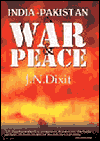| |
BOOK REVIEW
India and Pakistan: The
ever-ever antagonism
India-Pakistan in War & Peace, by J N Dixit
Reviewed by Sreeram Chaulia
 I
once witnessed a pitched debate between former Indian foreign
secretary J N Dixit, alias "Mani", and peace activist Praful
Bidwai on the pros and cons of India going nuclear in May 1998.
Bidwai argued emotionally and rhetorically against India "losing
its soul in Pokhran" (in a theatrical style which has now been
popularized by novelist Arundhati Roy), as Dixit proceeded to
professionally and dispassionately adumbrate the security
requirements and milieu in Asia that necessitated the Indian
nuclear tests. I
once witnessed a pitched debate between former Indian foreign
secretary J N Dixit, alias "Mani", and peace activist Praful
Bidwai on the pros and cons of India going nuclear in May 1998.
Bidwai argued emotionally and rhetorically against India "losing
its soul in Pokhran" (in a theatrical style which has now been
popularized by novelist Arundhati Roy), as Dixit proceeded to
professionally and dispassionately adumbrate the security
requirements and milieu in Asia that necessitated the Indian
nuclear tests.
I came out with the distinct impression that whether one agreed
or not with Dixit's defense of "Smiling Buddha II" - as the
nuclear device is popularly called - the man was a walking,
talking encyclopedia who could rattle off facts and incidents at
will and at apposite moments on any subject pertaining to South
Asian politics and foreign relations.
A prolific writer and speaker since retirement from the Indian
foreign service, Dixit has come up with this volume covering the
entire breadth of India-Pakistan animosity, adding another
feather to his plume as the one foreign secretary who never went
out of vogue, long after superannuation.
If anyone still has doubts whether Mani Dixit is a one-man think
tank, this anecdotal and racy survey of the "ever-ever" enmity
between India and Pakistan, to borrow a phrase from author
Francis Fukuyama, is the clincher. In depth of knowledge and
foresight, India-Pakistan in War & Peace pleases, endears
and also fills crucial gaps in understanding of recent and
not-so-recent events of sub-continental history.
Present backwards
Dixit has chosen an anticlockwise narrative, beginning with the
IC-814 plane hijacking and the Kargil war (May-July 1999), and
then returning to the historical developments of India-Pakistan
tussles from independence in 1947. A "gradual, logical and
chronological approach would diminish the sense of urgency with
which India should assess and react to Pakistani antagonism,
which goes beyond territorial disputes or strategic worries". (p
19)
The author, a member of India's National Security Advisory
Board, presents behind-the-scenes information about the
involvement of Pakistani authorities in the Indian Airlines
hijacking of December 1999. In Kathmandu, as a prelude, senior
Pakistani diplomats and Inter-Services Intelligence (ISI)
officials went to the Tribhuvan airport departure lounge and
"had some last minute discussions with the leader of the
hijacking group".
Refueling of the hijacked plane en route to Kandahar in
Afghanistan was done at Lahore, with Pakistani military officers
present at the air traffic control tower. After the Taliban gave
safe passage to the terrorists released by India in exchange for
civilians in the plane, they proceeded with fanfare to Pakistan.
Maulana Masood Azhar's triumphant march throughout his home
province had the blessings of local Pakistani government
authorities. Pakistani officials were present at Bahawalpur,
where Azhar swore to raise an armed cadre of half a million
people to continue the jihad against India. What worries Dixit
most is that "the common people of Pakistan did not react to the
hijacking in a manner influenced by humanitarian
considerations". (p 33) They felt it was "incidental" and part
of the general support that the ISI gave to terrorist cadre.
The Kargil war must be seen as a continuation of the unalterable
objective of the Pakistani power structure: forcibly wresting
Kashmir from India. Dixit's evaluation is that the single most
important factor propelling Kargil was the personality of
warmongering army chief, General Pervez Musharraf. "He believed
that a sustained campaign of subversion and military intrusion
would result in Pakistan achieving its objective of annexing
Kashmir," and staunchly defended jihad as a "tolerant concept
embodying commitment to Islam". (p 38). Like specious defenses
of innocence in the IC-814 episode, Pakistan's claim that Kargil
did not involve regular troops but only mujahideen was disproved
by the fact that "irregulars, barring foreign mercenaries, were
used as porters and logistical support personnel by the Pakistan
army". (p 51) Every foreign government, including Pakistan's
ally China, acknowledged that the Line of Control that divides
Kashmir had been violated by Pakistan as a unilateral
provocative act and that Pakistani infantry troops were directly
involved in the aggression.
Again, disappointingly for those who imagine that
people-to-people relations are the panacea for the
India-Pakistan conflict, Pakistani public opinion (except in
Pakistan-administered Kashmir) swallowed government propaganda
during Kargil that the misadventure was "launched substantially
by Kashmiri militants". (p 75) The lesson for India from Kargil
and IC-814, according to Dixit, is that bilateral dialogue at
any level should not be undertaken with any excessive
expectation and should not be predicated on the sincerity of
Pakistan.
Wellsprings of hatred
While there are theories that Muslim separatism and antipathy to
"Hindu India" dated back to medieval times or to the anointment
of Aurangzeb as Mughal emperor instead of Dara Shikoh, Dixit
thinks that the half century from 1803, when Muslim political
power crumbled before the British onslaught, was the cementing
factor in raising anxiety among undivided India's Muslim
intellectuals. The operational styles of both Tilak and Gandhi,
not to mention British policies, crystallized suspicions about
the Hindu majority in the psyche of Indian Muslims. Partition
and its attendant horrors were "seeds of communal antagonism,
sown over the previous 50 to 90 years, which were sprouting
through the ground as poisonous saplings". (p 108) The moment
Pakistan's founding father Muhammad Ali Jinnah complained of
receiving a "moth-eaten and truncated Pakistan" in 1947, the
seeds of hostility based in religion took on territorial
identity. General Akbar Khan, who led the Afridi invasion of
Jammu and Kashmir in 1947, laid down the golden rule that has
caused untold bloodshed for 55 years: "The accession of Kashmir
to Pakistan was not simply a matter of desirability but an
absolute necessity for Pakistan's separate existence." (p 114)
Existing contradictions were compounded from 1958 by a "major
ideological chasm" with India's commitment to democracy and
Pakistan's transformation into a military-bureaucratic
authoritarian state. Field Marshall Ayub Khan's era (1958-1965)
was characterized by ups and downs in bilateral relations, with
a few positive elements like the Indus Waters Treaty and
proposals for a mutual defense pact, but a steep escalation in
Pakistani war plans over Kashmir.
Then foreign minister (later president) Zulfikar Ali Bhutto's
basic hypothesis that the Kashmiri people would rise in support
of guerrillas and the Pakistan army in the 1965 war fell flat as
locals supplied steady information about infiltration routes and
hiding places to the Indian army. Pakistan's usage of code names
such as "Operation Gibraltar" (in memory of the Arab invasion of
Gibraltar in AD 711) and "appeals to the collective historical
and assertive Islamic memory of a conquest nearly [a] thousand
years earlier" did not shake the basic secular fabric of India
in 1965, although Chinese ultimatums and diplomatic pressure
prevented a decisive result in the war. Interestingly, again,
though Indian premier Lal Bahadur Shastri made strategic
concessions of Haji Pir, Kargil and Uri-Poonch at the Tashkent,
it was Pakistani public opinion which was inflamed, led by
Bhutto slamming the peace agreement as a "surrender and a
betrayal".
The rearrangement of Pakistan
Bhutto's jingoism and communal anti-Indian mentality were
unmatched even in the hard core of Pakistan's armed forces. His
top secret memorandum to Ayub Khan after the 1965 debacle
advocated revenge by not just acquiring Kashmir by force, but
also by the dismemberment of India in its eastern extremities
with Chinese assistance. As the Bangladesh movement picked up
momentum, he accused the Awami League of Mujibur Rehman to be a
"pro-Hindu organization that was going to affect the Islamic
identity of Pakistan". (p 172) The 10 million refugees who fled
genocide and reached India were labelled "rebels", "secessionist
miscreants" and "majority Hindus".
An interesting sidelight of the 1971 war that led to the birth
of Bangladesh was that when Henry Kissinger and high-level
American missives warning India not to take military action for
Bangladesh did not convince Indira Gandhi, the US ambassador to
Delhi threatened stoppage of economic assistance to India. Mrs
Gandhi, without batting an eyelid, suggested "immediate closure
of the USAID mission office in Delhi". Another lesser known
incident before the December war was that during the visit of
famous foreign dignitaries to the Bangladeshi camps in West
Bengal, French author Andre Malraux was so moved that he wrote
about his desire to mount an Indian army tank and wage war
against the military oppressors of Pakistan. Dixit also recounts
the delightful episode of Mrs Gandhi chiding General Manekshaw
for drinking during military briefings, to which he replied,
"Madam, the brand name of the whisky is Black Dog, which
[President] Yahya Khan drinks. I am quite sure that I shall
overdrink him and outfight him. Please do not get angry." (p
210) One of the Pakistani myths broken in 1971 was that "India
as a pacifist and soft state dominated by the Hindu ethos could
not match Pakistan's martial traditions". (p 223)
At Simla, Bhutto pleaded with Mrs Gandhi not to publicly
disclose his commitment to convert the LoC into a de jure border
over three to five years, but quickly reneged on the oral
promise by starting a covert nuclear program in 1972 and
embarking on a grand strategic Islamic alliance to counter
India's influence and stature in Asian, West Asian and Gulf
politics. Most ominously, "Bhutto was accurate in this
perception about Mujib's subconscious Islamic inclinations and
innate reservations about India." (p 231) While crowds jostled
around Bhutto's car on his first state visit to independent
Bangladesh, shouting "Bhutto Zindabad" and "Pakistan-Bangladesh
friendship Zindabad", Dixit, who was the Indian High
Commissioner, was harassed and booed with anti-India slogans.
The Islamization and anti-India postures of Bangladesh reached
full crescent with Ziaur Rehman's military coup and have not
ceased ever since.
Zia to Musharraf: The deepening cleavage
General Zia ul-Haq planned a thorough refashioning of
India-Pakistan relations in a manner whereby compromises made by
Pakistan since 1971 could be reversed. From 1979-1980, Pakistan
established connections with extremist Sikhs in Punjab for
fomenting the Khalistan movement against India, adroitly using
Sikh pilgrimages to Pakistan for recruiting top level commanders
(some of whom are state guests to this day, cocking a snook at
the Indian government's "20 most wanted" demand). Zia had a
two-track policy from 1981 onwards, "An apparent peace
offensive, while encouraging covert moves to erode India's
unity, influence and strength." (p 248) Concurrent with the
total Islamization of Pakistani society, Zia appointed himself a
spokesman for Indian Muslims, claiming "my heart bled for them
when they are victimized". Dixit's riposte to establishment
claims from Islamabad that India was engaging in "uncivilized
behavior" against minorities is that "this criterion should be
suitably applied to Muslim rulers, beginning from Mahmud
Ghaznavi to Aurangzeb and latter-day rulers of Pakistan". (p
254)
Operation Brasstacks (1987), the nearest the two sides had come
to war since 1971, was a classic example of the heightened
mistrust between India and Pakistan that emerged out of Zia's
machinations. Pakistani nuclear scientist Abdul Qadeer Khan's
"revelation" to Kuldip Nayar in March 1987 that Pakistan
possessed the atomic bomb was an orchestrated attempt at
coercive diplomacy by Zia, further warning India that Pakistan
was going the nuclear route to change the dynamics of the
Kashmir contest. Zia also used nukes to develop South Asian
allies, telling them that Pakistan's nuclear weapons capacity
served the purpose not only of its own security but also to save
the smaller neighbors from Indian hegemony.
Benazir Bhutto took Rajiv Gandhi's apolitical past and genuine
desire to improve relations for weaknesses and hoped that she
could get him to compromise on the Kashmir issue in December
1988. When Rajiv firmly stood by India's interests, Benazir
upped the ante in clandestine activities, which coincided with
and whetted the 1989 tumult inside Indian Kashmir. Benazir's
highly militant and aggressive postures on Kashmir led to
speculation about a new war in 1990, which was the first
instance of American diplomatic mediation through the Gates
mission of what could have been a nuclear confrontation.
Prime Minister Nawaz Sharif sent positive signals to India
assuring that Benazir-style bravado would give way to "change in
the ground situation" (read cessation of armed support to
mujahideen). But whether civilian or military, no Pakistani
ruler was able to extricate Islamabad from its religio-communal
compulsions regarding Kashmir. Dixit says that "regardless of
their political affiliations, Pakistani leaders remain prisoners
of an all-embracing anti-Indianness". (p 282) The ill-treatment
of diplomat Rajesh Mittal in 1992 also showed how Pakistani
public opinion accepted official media portrayals of Indian lies
and conspiracies to be behind acts of wanton violence and
violation of international law. So vehement is the public
opinion angle to anti-India policies, that Dixit recounts
Pakistani Foreign Secretary Shamshad Ahmad "reminding" Nawaz
Sharif in 1997 before Indian premier Inder Kumar Gujral that a
proposed gas pipeline from Turkmenistan through Pakistan to
India "could not be undertaken as there would be opposition from
Pakistani public opinion unless the Kashmir problem was resolved
first". (p 301)
From 1992-93, Pakistan's rhetoric on Kashmir shifted from
"self-determination" to "violations of human rights by Indian
security forces", allegations which were effectively rebutted at
various world forums by Dixit and his successor foreign
secretaries. Islamic terrorism emanating from Pakistan was
successfully presented by Indian governments in the 1990s as the
core problem, not human rights. In the late 1990s, the Gujral
Doctrine of magnanimity did not yield any quid pro quo from
Pakistan, leading Dixit to comment that "the doctrine was not
rooted in reality". Even Atal Bihari Vajpayee's much-heralded
visit to Lahore in February 1999 was bound to fail, as no sooner
had he visited the Minar-i-Pakistan, Islam-pasand parties washed
its entire platform in a public ceremony "to purify it from the
malign impact of the visit of an infidel prime minister of the
enemy country". (p 304) Uncontrolled Islamization and
Talibanization of Pakistan were the strongest anchors backing
the Kargil invasion which followed.
General Musharraf's statements as late as January 2002 that
Pakistan would not accept any solution of Kashmir based on the
LoC and his repeated warnings that Pakistan will use "all means
available" (ie nuclear) in a conventional war have taken the
story of India-Pakistan squabbles into familiar territory of
mistrust and tension. Daredevil attacks on the Jammu & Kashmir
assembly, the Red Fort and Indian parliament and countless acts
of terrorist infiltration and violence in Indian Kashmir have
added to the sting of mutual bitterness.
Psychological hurdles to normalization
Towards the conclusion, Dixit identifies a series of Pakistani
traits that refuse to live amicably with India. First,
"artificially nurtured memories of Muslim superiority and a
subconscious desire to rectify the unfair arrangements of
partition". Second, a certain envy Pakistanis would not
acknowledge openly about the failure of their civil society to
solidify democratic and tolerant traditions in comparison to an
India where khakis and bayonets follow popularly elected
representatives. Third, assumption by Pakistan of the role of
protector and overseer of the welfare of Indian Muslims, who in
the words of Maulana Azad, could be exploited from forces across
the border owing to their "socio-political schizophrenia" since
partition. Fourth, avenging the military defeat of 1971, which
is a formal objective declared in the official oath-taking
ceremony of every Pakistani officer-cadet when he graduates.
Fifth, irrational faith in the "profound capacity for commitment
to jihad amongst the momin", as was publicly declared by Foreign
Minister Gauhar Ayub Khan at a press conference in Delhi. Sixth,
confidence that Pakistan's nuclear weapons program is an
instrumentality to further geopolitical objectives in Kashmir.
Seventh, widespread belief in the Pakistani establishment and
media circles that India is getting exhausted in Kashmir and
would not be able to hold on to it for long (a presumption of
Musharraf in Kargil). Eighth, and most significantly, "the
unarticulated ambition and hope that if India broke up, Pakistan
will emerge as the strongest and most powerful political entity
in South Asia". (p 392)
For all the Vajpayee government's "bold and dramatic"
initiatives since 1998 to break the log jam with Pakistan (the
latest Agra Summit of 2001, incidentally, was L K Advani's
brainchild, according to Dixit), unless there is an alteration
of the above eight fault lines, no permanent peace can be
expected. Unless there is a "fundamental transformation of the
power structure in Pakistan, not only in terms of its military
components but also of the social background and political
inclinations of the plutocratic and feudal leadership" (p 437),
the "ever-ever" antagonism will persist.
Mani Dixit's tome is decidedly an Indian version of the causes,
symptoms and course of India-Pakistan fencing, but the fact that
he was in the thick of diplomatic wrangles and peace initiatives
since the 1970s, and the illuminating anecdotes and personal
impressions he packs into this book will make it a primary
reference guide for students of South Asian history and
politics. For one, if Indian politicians understood as much as
Dixit about Pakistan, there may be hope for more realistic and
problem-solving policies.
India-Pakistan in War & Peace, by J N Dixit,
Routledge Publishers, London, 2002. ISBN 0-415-30472-5. Price
US$27.50, 501 pages.
(©2002 Asia Times Online Co, Ltd. All rights reserved. Please
contact
[email protected] for
information on our sales and syndication policies.)
|
| |
|
|
 |
|




 I
once witnessed a pitched debate between former Indian foreign
secretary J N Dixit, alias "Mani", and peace activist Praful
Bidwai on the pros and cons of India going nuclear in May 1998.
Bidwai argued emotionally and rhetorically against India "losing
its soul in Pokhran" (in a theatrical style which has now been
popularized by novelist Arundhati Roy), as Dixit proceeded to
professionally and dispassionately adumbrate the security
requirements and milieu in Asia that necessitated the Indian
nuclear tests.
I
once witnessed a pitched debate between former Indian foreign
secretary J N Dixit, alias "Mani", and peace activist Praful
Bidwai on the pros and cons of India going nuclear in May 1998.
Bidwai argued emotionally and rhetorically against India "losing
its soul in Pokhran" (in a theatrical style which has now been
popularized by novelist Arundhati Roy), as Dixit proceeded to
professionally and dispassionately adumbrate the security
requirements and milieu in Asia that necessitated the Indian
nuclear tests. 



